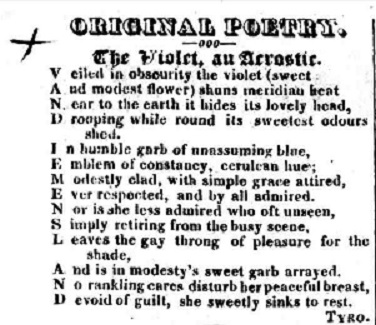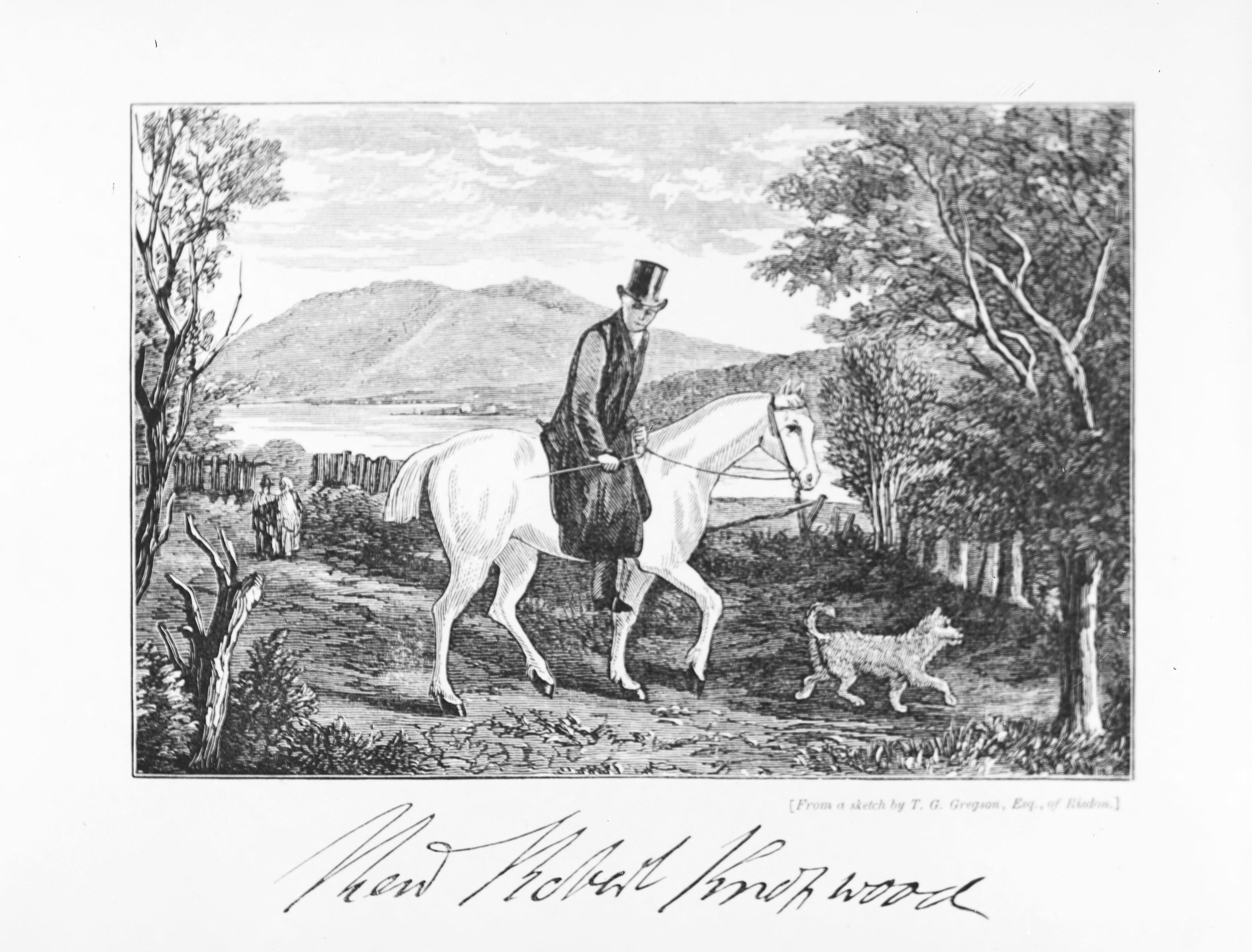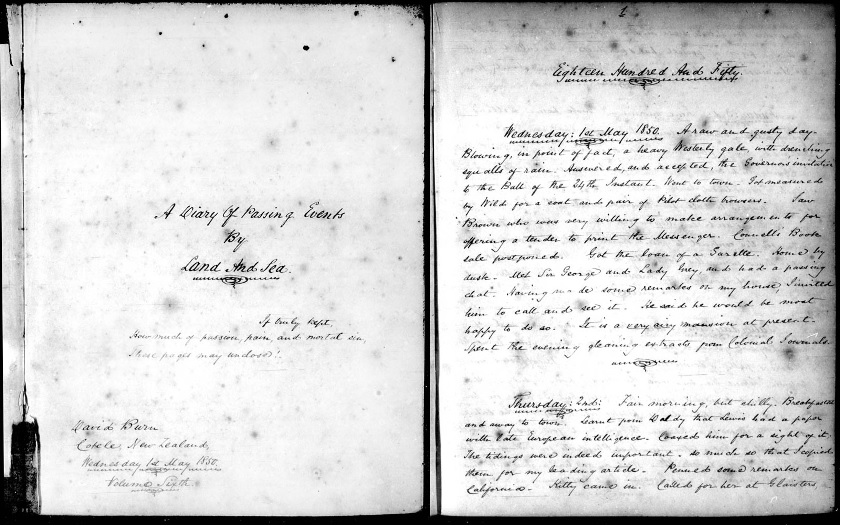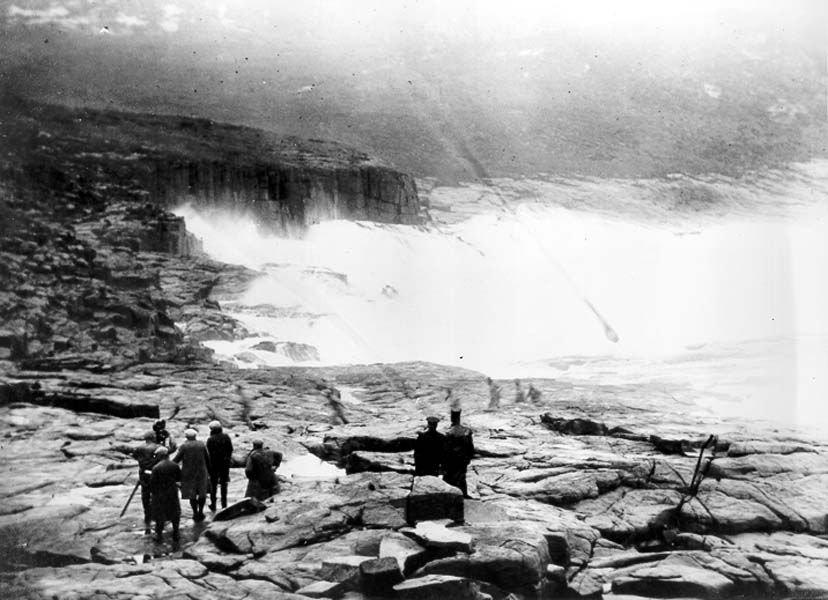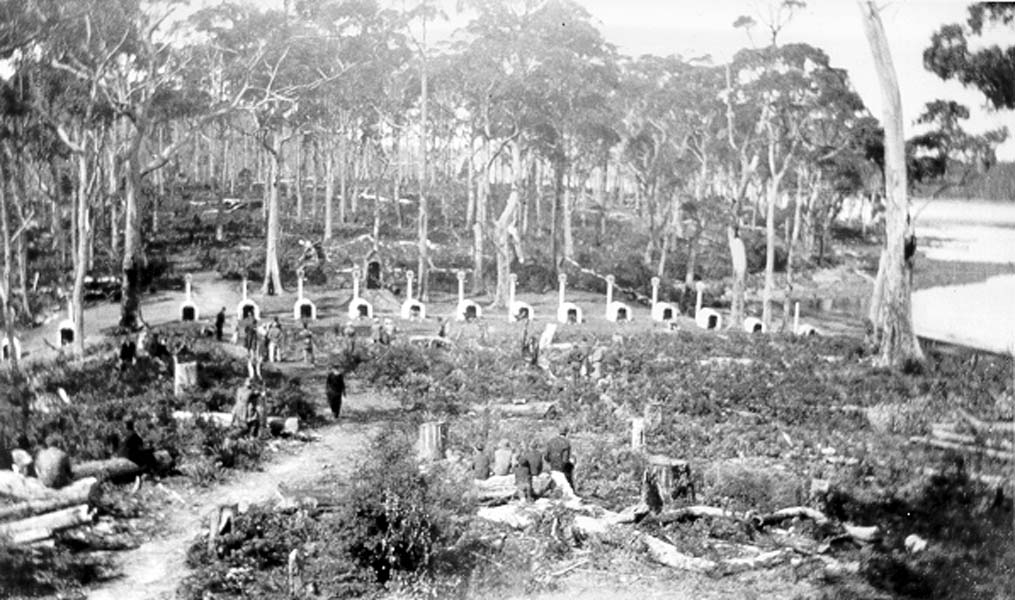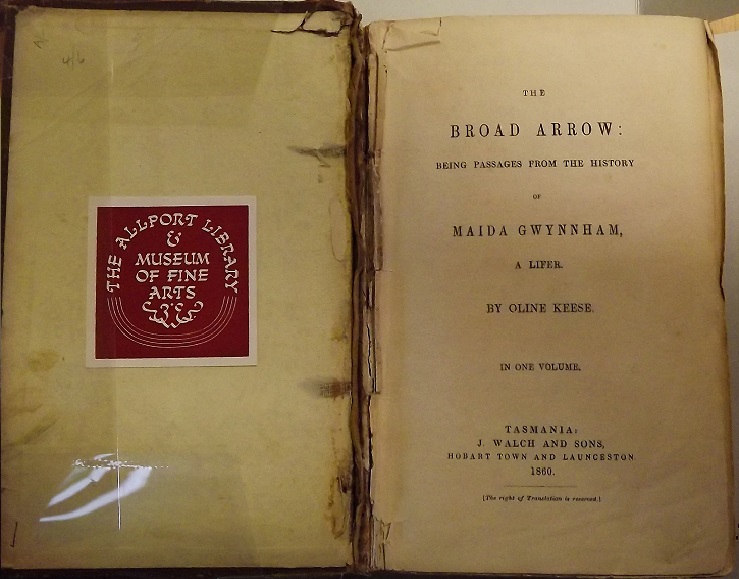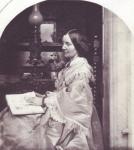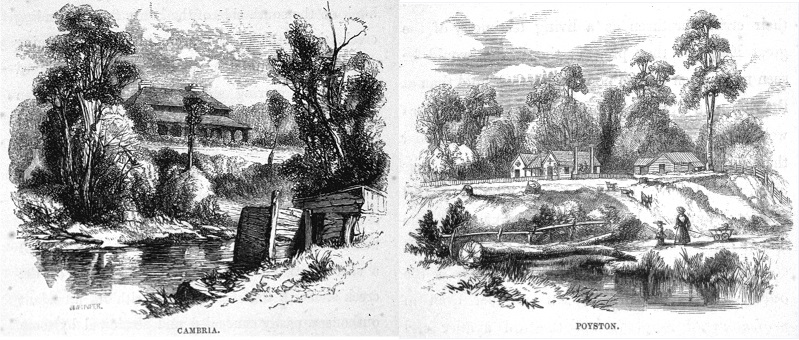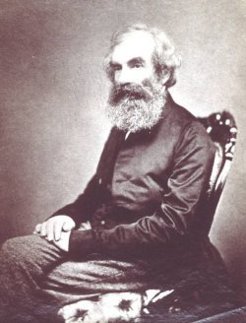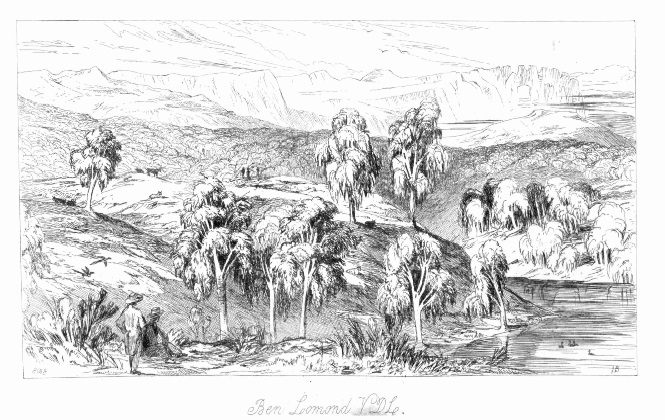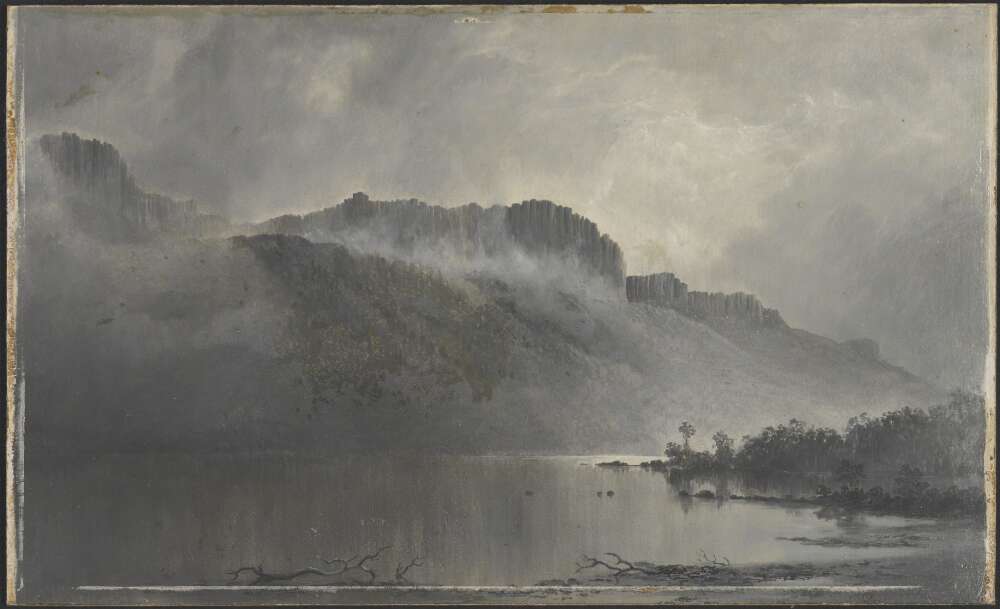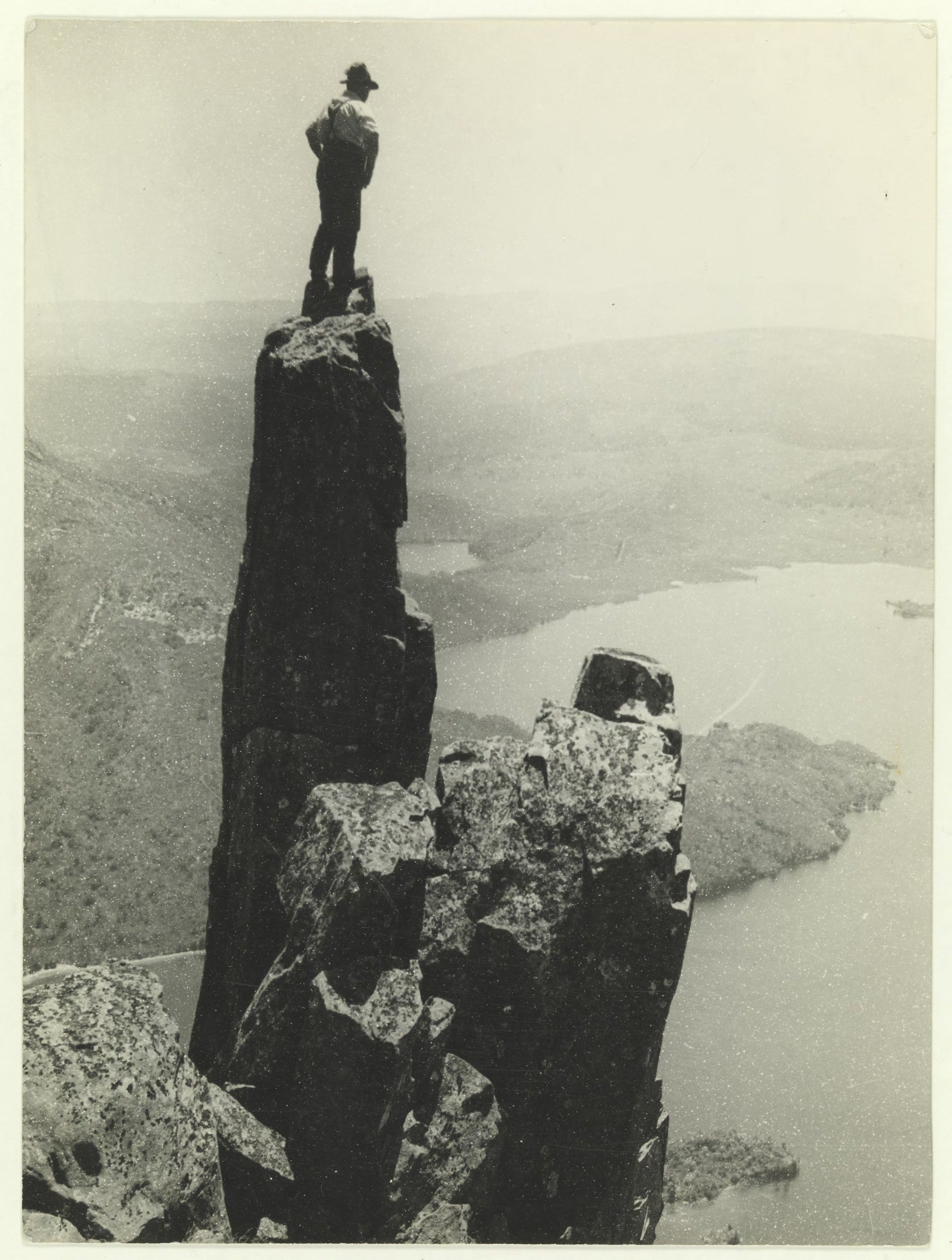AustLit
-
The sense of place is a notable aspect of early settler life in Van Diemen’s Land. The regular inclusion of verse in newspapers of the first half of the 19th century appeared under headings like ‘Original Poetry’ and often display a range of different views about the landscape, seasons and environment. An entirely conventional pastoral verse like 'Harvest Home' in the Launceston Examiner (14 March, 1849, p. 167) has the place marker, ‘Arcadian Village, North Esk’ attached. 'The River Tamar - In Van Diemen's Land' is a typically Wordsworthian evocation of a native landscape, ‘Tamar’s wild, meand’ring, placid stream’ (Launceston Examiner, 15 March, 1843, p. 166). ‘Heart of the South’ in the Colonial Times and Tasmanian Advertiser (19 August, 1845, p. 4) about an ‘isle that looms in the Southern seas,/ Fanned by an ice-cooled and temperate breeze’ includes this footnote about its title: ‘Alluding to the shape of a heart, which the shores of Van Diemen’s Land delineate.’ Amongst the many other poems on topical subjects, elegiac laments and satiric commentary, the poems about landscape and place in these early publications often evince a strong sense of identification, a sentimental pride in native birth rather than nostalgia for the old country. This array of writing supports James Boyce's argument that the experience of early British settlers of Van Diemen’s Land, as compared to that of mainland New South Wales, was ‘greatly at variance with the standard opening of the national story’ (5). They were islanders in a place apart.
-
Poetry also allowed a kind of political expression not easily accommodated or visible in other early colonial writings. ‘The Native's Lament,’ for example from the Colonial Times in 1826 (5 May), begins in the first person of an Aboriginal of the Huon, lamenting the loss, after the arrival of the white convicts and settlers, of his ‘home of the free and the wild.’ The ‘stranger has found the fair clime/ And comes with the sons of misfortune and crime […] He usurps the best lands of thy native domains.’ The word ‘invasion’ was used as early as 1823 in the Hobart paper The Mirror of Literature, Amusement, and Instruction: ‘the natives of Van Diemen’s Land are few in number considering the extent of country which they yet hold free from European invasion’ (Saturday, January 25, 1823, p. 194). It might be mentioned here that the acrostic sonnet on the name Van Diemen’s Land was popular in colonial newspapers presumably because of the name’s 14 letters.
-
We can see other early responses to place in colonial Tasmania in the diaries of the Reverend Robert Knopwood (1763-1838), a ‘sporting parson,’ who described daily life, at every level, in early Hobart and around the Derwent estuary. Knopwood’s diary is the source of the narrative of the cannibal convict Alexander Pearce, interviewed by Knopwood after his first escape. The first Surveyor General of the colony, George William Evans, who worked there from 1809, wrote A Geographical, Historical, and Topographical Description of Van Diemen’s Land (1822). Designed to provide ‘useful information respecting the application for grants of land,’ he included a large chart of Van Diemen’s Land and descriptions of landscape for the interest of intending emigrants. Similarly, Edward Curr’s An Account of the Colony of Van Diemen’s Land (London, 1824) opens with a ‘description of the country’ and is subtitled ‘Principally Designed for the Use of Emigrants.’ There are other non-fiction writings in journals and papers of colonial figures like the Port Arthur Commandant Charles O’Hara Booth (1800-1851) exploring the Tasman Peninsula (see McMahon ‘The Gilded Cage: From Utopia to Monad in Australia's Island Imaginary’), the architect and explorer Henry Hellyer (1790-1832) who surveyed the far north-west of the island, the later surveyor George Frankland (1800-1838) who published An Expedition to the Head of the Derwent and the Countries Bordering the Huon (1835) and who is responsible for the names of Mount Olympus and Mount Ida in the Highlands.
-
The Hobart Town Magazine (1833-34) was the ‘first monthly magazine [in Australia] with definite pretensions to literature’ (Morris Miller 49) and published serials, poetry, short fiction, reviews, and ‘domestic intelligence.’ The magazine published allegories of settler dispossession like ‘Tasmania, A Poem,’ an instance of the early circulation of the non-official name, where the island long ‘slumbered! Pillow’d on the main!’ and is found by Britain and adopted, a younger brother ‘to Australia’ by ‘a few short years’ (1.11 January, 1834). James Ross published numerous articles about convict life in early papers like the The Hobart Town Courier (1827-40), some of which Marcus Clarke used as sources for His Natural Life.
Annie Maria Baxter Dawbin began a diary on her arrival in Van Diemen’s Land from England with her soldier husband in 1834. She later published extracts from the 32 volumes of these diaries as Memories of the Past (Melbourne: W.H. Williams, 1873), including her four or so years in Van Diemen’s Land. Her interests are in recording her experiences of living in a series of colonial and pioneering communities, the difficulties and tragedies of family life, and particularly her own social progress (see also Lucy Frost, A Face in the Glass: The Journal and Life of Annie Baxter Dawbin, 1992).
-
David Burn (1798-1875) was enraptured with the Van Diemonian landscape from his first encounter, sailing into the Derwent in 1826: ‘Talk of Killarney – the famed of legend and of song? The meanest reach of D’Entrecasteaux Channel outstrips it far in all its favourable attributes – wildness, richness, variety, or grace’ (Morris Miller 119). Burn had followed his mother to the colony and settled on a grant of land in the Ouse district. His The Bushrangers was the first Australian play to be written and performed (in Edinburgh, though, in 1829). Interested mostly in writing plays and journalism, Burn also contributed a series of lively and well written articles to the London Colonial Magazine in 1840-41, including ‘Scenery – the Derwent River,’ ‘Tasmanian Lakes’ and ‘Scenery on the Shannon River and Lake Clarence.’ These were collected in a facsimile volume in 1973, A Picture of Van Diemen's Land.
See also the AustLit entry on David Burn.
-
Other early playwriting in Tasmania included Evan Henry Thomas’s three-act The Bandit of the Rhine, which is notable for being the first original single play to be wholly written and published in Australia. Thomas came to Van Diemen’s Land in 1822, first to Hobart, then to Launceston where he was an active member of the Launceston amateur dramatic association. Catherine Shepherd (1901-1976), an emigrant to Tasmania in the 1920s, was a founder of the Hobart Repertory Theatre Society and a prolific writer of drama for the stage and ABC radio over four decades. She is one of Giordano and Norman’s Tasmanian Literary Landmarks.
-
Marcus Clarke’s His Natural Life has had a powerful influence on perceptions of Tasmania as a geographic location. The serialised version of the novel included a descriptive chapter ‘Hobart Town in 1830,’ later dropped from the book version. The better known passages in the novel are in the chapters ‘The Topography of Van Diemen’s Land’ (II.1) and ‘A Natural Penitentiary’ (III.xx). In the earlier chapter Clarke’s view is cartographic and metaphoric:
Viewed upon the map, the fantastic fragments of island and promontory which lie scattered between the South-West Cape and the greater Swan Port, are like the curious forms assumed by melted lead spilt into water. If the supposition was not too extravagant, one might imagine that when the Australian continent was fused, a careless giant upset the crucible, and spilt Van Diemen’s Land in the ocean. (112)
Tasman’s peninsula, Clarke also wrote, hangs ‘like a huge double-dropped earring, from the mainland’ (112). This landscape is a combination of the idyllic and the dangerous – ‘fertile, fair, and rich, rained upon by the genial showers from the clouds which, attracted by the Frenchman’s Cap, Wyld’s Crag, or the lofty peaks of the Wellington and Dromedary range – pour down upon the sheltered valleys their fertilizing streams’ (113-14) – but also surrounded by shipwrecks, the grim front of Mount Direction, and a ‘perpetual frown on the face of nature’ (114-15). The latter chapter describes how Eaglehawk Neck was low and narrow enough to allow a line of watchdogs and how the topography of the peninsulas ‘offered peculiar advantages to the signalmen’ of the semaphore system (374). In a sardonic tone, Clarke notes that these features allowed Colonel Arthur to report ‘to the Home Government that the spot which bore his name was a 'natural penitentiary' (374-75). These are some sources of the contentious descriptor 'Tasmanian Gothic' and they tend to persist in the multiple forms in which the radically variable narrative of Term has circulated – sometimes tragic, sometimes romantic – as serialized novel, revised serialization, pulp fiction, Penguin Classic, scholarly editions, Classic Illustrated comic, drama, film, musical, and tv mini-series.
See the full AustLit entry at His Natural Life.
-
One of the source texts for Clarke was Caroline Leakey’s The Broad Arrow (1859), convict fiction that also includes some vivid details of the Tasman Peninsula and the Port Arthur settlement. But it is equally interesting for its evocation of early Hobart town and surrounds. Leakey portrays Tasmania as a place where it is possible to escape the claustrophobia and, paradoxically, the death sentence of the English class system, where people are not condemned at birth to live meanly in thrall to their social superiors. She also portrays Tasmania as a place that needs to rise up against the imposition of the penal system in order to create a free nation, liberated from all the evils of convict transportation. The landscapes of convict fiction then, are both topographical and social.
-
Feature: Louisa Ann Meredith
Louisa Anne Meredith (1812-1895), with her husband (and cousin) Charles Meredith, settled on the east coast of Tasmania in the early 1840s. When Nicholas Shakespeare emigrates to the same coast in the early 2000s, it is on land once owned by the Merediths. Louisa Ann had grown up in Birmingham and been home schooled by her mother. Her husband had emigrated to Van Diemen’s Land in 1821, following his father, but returned to England in 1838 when he married Louisa. A talented botanical artist, Meredith was also a dedicated chronicler of pioneering life in Australia. She published very popular sketches of colonial life, drawings of wildflowers, fiction and seven books of poetry. Her two volumes of My Home in Tasmania, During a Residence of Nine Years was published in London in 1852 and includes chapters on ‘The Journey to Swan Port,’ ‘Ascent of the Sugarloaf,’ ‘Gum Tree Forests,’ ‘Picnic Parties,’ ‘Bush Fire,’ ‘Excursions to the Schoutens,’ ‘Garden-making,’ ‘The Hunt,’ ‘The Opossum at Supper,’ ‘A Fern Valley,’ etc. Her narratives, drawings and observations were deliberately designed to encourage British emigration to the colony – come out and join us, our place is like home. And their rhetoric of ‘islandness’ is instinctively well designed to appeal to atavistically insular Britons. Michael Sharland has a chapter in Oddity and Elegance (1966), ‘Old Books, Old Homes’ which is a reverential, Romantic account of the Meredith colonial homes on the East Coast: Malunnah, Cambria and Riversdale.
-
In the attempt to reassure intending emigrants that the native problem is a thing of the past, Meredith’s narratives of pioneering life on the central east coast of Tasmania actually reveal the violent and racist underside of the region’s history. In a characteristically gendered move in chapter XII of volume 1 of My Home in Tasmania Meredith claims to know nothing herself about the Aborigines ‘from personal observation’ but writes that her husband Charles’ ‘experience of the habits and deeds of the aborigines extends over many years’ (190). Louisa then hands over to her husband on such a complex and difficult subject, quoting directly from ‘Mr Meredith’s own notes’ about the killings that occurred at Grindstone Bay in 1823 (193). This event, involving the Oyster Bay tribe and ‘Musquito,’ an Aboriginal from Sydney, sets in train bloody years of conflict on the East coast but also on other Meredith land, further inland, near Jericho and Spring Hill. (The story of Musquito, sent from Sydney to Norfolk Island, then Van Diemen’s Land, and hanged at the Cascades in 1825 is one of George Mackeness’s lightly fictionalised crime biographies in Lags and Legirons, 1944.) The ‘Hooper massacre’ is recounted in this chapter of Meredith’s transcription of her husband’s notes and is also the subject of her extended narrative poem 'A Tasmanian Memory of 1834 : in five scenes' published in Hobart by J. Walch & Sons in 1869. The story of the killing of Hooper, his wife, and their ‘seven or eight’ children by Aboriginals is about ‘those days of terror’ and ‘the tribes with whose brute thirst/ For blood those early days were curs’d’ (see Grimshaw). And the ‘memory’ of the poem’s title is directly linked to the event that triggered Arthur’s Black Line and consequently the disapproval of the home government at settler violence. The poem is about remembering frontier conflict of the past only as a reminder of the innocence of the settlers and of the ‘fiendish butchery’ of the natives (‘Memory’ 24). The poem perpetuates the legend of a family massacre, while contemporary evidence is that only Hooper was killed. It is a genocidal apologia for ‘The Saxon foot,’ which ‘with onward step,/ another race treads out,/ which scarce a vestige leaves, to tell/ It ever was – or to dispel/ The Future’s curious doubt.’ The most memorable images in the poem, tellingly, are of Aboriginal people hiding within a landscape as ‘Four stumps, black and crook’d,’ ‘ugly shapes, black, weird, and grim’ (13-14). Charles Darwin, in his account of visiting Tasmania on The Beagle in 1836, used exactly the same imagery in his description of Arthur’s Black Line, an effort to drive the Aboriginals into the Tasman Peninsula:
The attempt failed; the natives, having tied up their dogs, stole during one night through the lines. This is far from surprising, when their practised senses, and usual manner of crawling after wild animals is considered. I have been assured that they can conceal themselves on almost bare ground, in a manner which until witnessed is scarcely credible; their dusky bodies being easily mistaken for the blackened stumps which are scattered all over the country. I was told of a trial between a party of Englishmen and a native, who was to stand in full view on the side of a bare hill; if the Englishmen closed their eyes for less than a minute, he would squat down, and then they were never able to distinguish him from the surrounding stumps. (472)
See also the AustLit entry on Louisa Anne Meredith.
-
Feature: James Backhouse
James Backhouse (1794-1869), along with his Quaker colleague George Washington Walker, arrived in Van Diemen’s Land in 1832 and travelled extensively throughout the colony, ‘for the purpose of discharging a religious duty,’ and with the support and encouragement of Governor Arthur (Backhouse, Narrative xv). Their reporting for Arthur was largely about the social aspects of the colony, particularly convicts and Aborigines, but Backhouse was also a serious botanist and amateur field naturalist who made a special study of Tasmanian plants. In the chapters about his and Walker’s travels throughout Tasmania in A Narrative of a Visit to the Australian Colonies (1843) forensic reports on ‘Flagellation,’ ‘Chain Gangs,’ and ‘Orphan Schools’ alternate with etchings of grass-trees, constant descriptions of landscape features, forests and bird life.
-
Backhouse’s field naturalist and exploratory writing is an early instance of an important tradition of travel writing – at walking pace usually – by Tasmanian writers whose work has been little recognised for its narrative interest, scientific observation and environmental values. E.T. Emmett (1871-1970), Charles Barrett (1879-1959), Michael Sharland (1899-1987) and G. Hawley Stancombe (1914-2002) all wrote from a heritage and touristic perspective and were also very aware of popular, English heritage travel writers like H.V. Morton. Barrett’s Isle of Mountains: Roaming through Tasmania (1944), an account of a government-funded ramble for the purposes of promoting Tasmania, suggested by Emmett as Director of the Tourist Bureau, highlighted the ‘native beauty supreme’ of the island beyond the towns and cities. The opening of Emmett’s Tasmania by Road and Track (1952) is worth quoting for the sense the writing gives of this kind of evocation of place:
Very early one April morning I turned my back on Hobart and began a journey originally intended to be of 121 miles, but which ended by exceeding 1,400. It was between the G.P.O. and Augusta Road that this book was born, for as I trudged up Elizabeth Street, I reflected that although an observant globe-trotter had declared of Tasmania that he had “seen no country of the British Empire that was such a panorama of beauties,” the few books that had been written about the island had by no means exhausted the subject. Another traveller (Mr George Mendell) had included Tasmania as one of the four most lovely islands of the world, but no Stevenson, no Belloc, no H.V. Morton had as yet wandered this way. Though Anthony Trollope travelled here in 1872. Tasmania still awaits “discovery.” (11)
-
This opening mirrors Morton’s very popular In Search of England (1927) where he turns his back on London and sets off in search of an artisanal, pre-industrial England. Tasmania by Road and Track has a kind of antiquarian style, like Morton’s, with chapter summaries like the one for Chapter 1: ‘I search for history on the Hobart-Launceston road and find it in plenty, discover a beachless Brighton, walk through an appleland and tell of a trouble-making pioneer’ (11). Later, Peter Conrad in an updated version of this kind of writing, in his Down Home : Revisiting Tasmania (1988) will describe in ambulatory, panoramic detail the long walk into Hobart and back out to his home at Goodwood. Emmett had been an executive member of the Scenery Preservation Board, when it was formed in 1915. This was a government department tasked with preserving natural heritage and was a predecessor to the Parks and Wildlife Service. Emmett went on to become the first director of the Tasmanian Government Tourist Bureau.
A journalist with the The Mercury for most of his career, Michael Sharland became secretary of the Tasmanian Scenery Preservation Board in 1947. Both he and Emmett had long family histories in Tasmania, stretching back to colonial times. In Stones of a Century (1952) and Oddity and Elegance (1966) Sharland is obsessed with discovering a landscape of illusory antiquity in the present – stone-hewn villages, Georgian mansions, old estates – that expresses a spectral continuity with the colonial past and that remains an element of fictional, heritage and touristic discourse today:
Through the Midland country where oak and elm and gum tree murmur like the sound of little, unheard voices, and the moon intensifies the shadows and silvers the surface of the streams that flow beneath the ancient bridges, dust rises from the edges of the road like that from the hoofs of horses, as if the ghosts of the stage coaches and their splendid teams still lingered amid the scenes that knew them long ago. (Stones of a Century 29)
Stones of a Century also devotes a whole chapter to Tasmanian ghosts, another rich vein of popular writing with various claims to Tasmania’s being the most haunted of Australian states (see Will Mooney, ‘Ghost Stories’ in Alexander, Companion to Tasmanian History). Other travel writing includes G. Hawley Stancombe’s Highway in Van Diemen's Land (1968; illustrations by E.V. R. Ratcliff). Like his Evandale neighbor Karl von Stieglitz, Stancombe was a farmer and local historian and Highway in Van Diemen’s Land is a unique example of regional and Australian literature of place, with its heritage strip-map of the old highway from Hobart to Launceston and the many sites imbued with history along the roadside. The title of Charles Whitham’s Rambles in Western Tasmania (2010, ed. Simon Kleinig), given the experience of escaped convicts from Macquarie Harbour, Lady Franklin on her trip to the west coast in 1842, and other walkers’ accounts of struggling with the bauera, might be considered provocative.
-
There are also Tasmanian writers for whom the place is either to be ignored or doesn’t seem relevant. The colonial administrator James Knox (1810?-1865), for example, was a prolific publisher of poetry and prose sketches in Van Diemen’s Land newspapers, sometimes under pseudonyms like ‘Tasmanicus’ and ‘Anglo Tasmanian.’ Even though he published his first book, Poetic Trifles (1838) in Hobart, only one poem was set there, ‘Impromptu on Mount Wellington.’ His ‘Transplanted Trees’ is included in Smith and Scott’s anthology Effects of Light and sums up his sense that life was elsewhere. A poet like A.R. Blackmore, for example, from Nugent, who fought on the Western Front and died from gassing and tuberculosis at the very end of World War I, seemed unattracted to the specifics of the Tasmanian landscape. Blackmore’s one volume, Shade and Echo: Verses , first published in 1909 and republished with additions in a memorial volume by his widow in 1920, was praised in the Bulletin in December, 1918. Like Knox he explored more metaphysical themes.
Helen Hodgman’s first novel Blue Skies (1976), an unexpected crime story, explores suffocating Hobart interior worlds, both personal and suburban, in the register of a woman’s postnatal depression. This version of Tasmania, shrunk to suburban Hobart and the dysfunctional nuclear family, seems to ignore the landscape elements of much other fiction and is also developed in recent novels of family trauma and dysfunction in suburban Hobart like Favel Parrett’s Past the Shallows (Hachette 2011) and When the Night Comes (Hachette 2014), the latter with more gothic elements. The central thread of Peter Conrad’s memoir, shorn of its island-wide return travel, is also of a blandly suburban Hobart. Such fictions raise the question of the sub-regional components of the Tasmanian literary imaginary. Christopher Koch’s idyllic East coast, Clarke, Flanagan, Geoffrey Blainey and Paul Collins’ West coast, Isabel Dick’s Huon Valley, Margaret Scott’s Tasman Peninsula, Fanny Cochrane Smith, Gwen Harwood and Cassandra Pybus’s D’Entrecasteaux Channel, children’s writers Nan Chauncy and Sally Odgers’ small farms, are all identifiably part of the literary island but not insular in themselves. They attest to the localised heterogeneity of literary insularity in Tasmania, also an effect of an anthology of short fiction like Deep South : Stories from Tasmania (Text 2013) that presents 24 stories ranging from colonial to contemporary writers.
-
Perhaps the most complexly ambivalent sub-region is the Central Highlands, including its periphery of the Midlands. Some readers of Tasmanian literature think that the idea of the ‘Highlands’ switches Tasmania from a little England to a little Scotland, underscored by Governor Macquarie’s solipsist toponymics and by apt pen-names like ‘Scotch Thistle,’ author of the novella Sunlight and Shadow: A Story of the Great Lake serialised in the Tasmanian Mail in 1896. What emerges from John Mitchel’s Jail Journal, romance novels like William Ferrar’s Artabanzanus: The Demon of the Great Lake: An Allegorical Romance of Tasmania: Arranged from the diary of the late Oliver Ubertus (1896) and paintings like W.C. Piguenit’s ‘Lake St Clair’ (1887) is a sub-region of lakeland reverie and fantasy which from the mid nineteenth century fitted European preconceptions of the picturesque and the beautiful (see Horne 44). Unexpectedly, though, it is also a landscape of dreams of political and psychic resistance (see Pierce, ‘Highlands’ 91). Ferrar’s Ubertus has a vision of the City of Eternity at Lake Sorrell and then descends into the underworld via the Great Lake, to the city of Pandapolis. There he meets the seven-foot tall demon Artabanzanus, ‘Demon of the Great Lake of Tasmania and Emperor of the World’ (43) and the narrative shifts to ‘uncensored political diatribe’ against the colonial government (Pierce, ‘Highlands’ 94). The Irish exile Thomas Meagher makes an appearance.
-
This imaginary, proto-Lovecraftian Highlands, with trapdoors into subterranean worlds, is a close relative of the teen horrorscape of Anna Dusk’s In-Human (Transit Lounge 2010), about a young werewolf in Oatlands – no doubt a ghost of tigers, sometimes called timber wolves, past. Also belonging to this imaginary is one of the most powerful of antipodal dream visions of the Tasmanian Midlands, the Freudian primal scene in A.D. Hope’s ‘Ascent into Hell,’ a memory of his Campbelltown childhood. In Hope’s reverse motion poem the speaker regresses from a Purgatorial Tasmania – Dante’s mount being in the Southern hemisphere – through the back door of Hell and exits out into the world through the underworld’s vestibule: ‘Lasciate ogni speranza, voi ch'entrate,’ the poem ending with this pun on Hope’s name, underlining the nightmare vision of his own birth. Hope (1907-2000) was born in Cooma, southern New South Wales, but his early childhood in Tasmania seems to have been formative of his imaginative life, if the thematics of his adult career as a poet is any guide. The insularity of Hope’s poetics is clearly traceable in his first volume The Wandering Islands(1955), which included the title poem and ‘Ascent into Hell,’ and through later poems such as ‘The Return from the Wandering Island,’ ‘Circe,’ ‘The End of a Journey,’ ‘Man Friday,’ ‘Hay Fever,’ ‘The Drifting Continent,’ ‘Tasmanian Magpies,’ and ‘In Memoriam: James Philip McAuley, 1976.’ The equation of islands, often specifically Tasmania, and dream, along with its cognates reverie, reminiscence, self-analysis, unconscious memory, and nightmare is noticeably consistent in Hope. Well aware of the significance of Freudian slips, Hope must have quite deliberately left Tasmania off the map of Australia in perhaps his most famous poem 'Australia' – but in a nice way. There are only five capitals in this poem, ‘like five teaming sores,’ and the ‘monotonous tribes’ of Australians stretch from Cairns to Perth, but not, it seems, across Bass Strait.
-
Beginning with Louise Lovely’s ‘mining romance,’ Jewelled Nights (1925, silent), an adaptation of Marie Bjelke-Petersen’s novel, and Norman Dawn’s adaptation of For the Term of His Natural Life (1927, silent), shot on the Tasman Peninsula, Tasmania has been represented in film and television, frequently in versions of literary texts, and featuring the landscape in various guises from touristic to Gothic. These include They Found a Cave (1962, first Australian children’s film in colour), The Last Tasmanian (tv documentary, 1978), Manganinnie (dir. John Honey, 1980), The Tale of Ruby Rose (dir. Roger Scholes, 1987), The Boys in the Island (1990), Young Einstein (1988), The Sound of One Hand Clapping (1998), The Potato Factory (tv, 2000), The Last Confession of Alexander Pearce and Dying Breed (both 2008), Van Diemen's Land (2009) and The Hunter (2011). Films produced by the Tasmanian Government Film Unit, the first such state government unit, included Frank Hurley’s travelogues Isle of Many Waters and Scenes that are Brightest (both 1939) filmed by Hurley for the Tasmanian Government Tourist Bureau. Isle of Many Waters begins with Hurley’s own voiceover: ‘All Tasmania is a lovely garden; endowed by nature with noble summits, lakes and splendid waterways.’ Neil Davis, the combat photographer from a small farm near Nala, trained as a cinematographer with the Tasmanian Government Film Unit on tourist travelogues like Valley of the Derwent (1950). He was killed in 1985 while filming a coup in Bangkok. Davis is the subject of a biography by Tim Bowden, One Crowded Hour (1987) and is the model for Christopher Koch’s hero, Mike Langford, in his novel Highways to a War (1995).
-
The Labyrinth in the Central Highlands was used as some of the background landscape in David Attenborough’s Walking with [CGI] Dinosaurs (1999). And Peter Conrad’s photography-based study At Home in Australia (2003) draws attention to the fact that the ‘first Australian daguerreotype, made in 1848 by J.W. Newland, shows Murray Street in Hobart sloping down to the wharf […] The first glimpse of an Australian city acknowledges that all cities are places of rapid transit, where the record of our existence is soon effaced’ (129). Tasmanian landscapes provided settings for periods in pre-history for Roger Scholes’ Stories from the Stone Age (2004). Tasmania has also played an ambivalent role in popular versions of the life narratives of the young Albert Einstein, Errol Flynn and Merle Oberon.
-
https://www.youtube.com/embed/dEL_BT_Z6Yg?rel=0
-
https://www.youtube.com/embed/8tmHbMzAfEc?rel=0
-
Roslynn Haynes’s Tasmanian Visions: Landscapes in Writing, Art and Photography (Hobart: Polymath, 2006) is the most comprehensive academic study so far about the ‘history relating to the Tasmanian landscape imaginatively’ (xii). Haynes argues that the ‘majority of poets and novelists [from Savery and Clarke on] have continued to create imaginative Tasmanian landscapes that reflect a darkly Gothic spirit of place, threatening and malign’ (xii). She sees the painters, like Glover and Piguenit, as well as other colonial and scientific artists, as emphasising the Picturesque and Romantic in their responses to Tasmania as landscape and sees ‘wilderness’ photographers like Olegas Truchanas and Dombrovskis as renewers of the same tradition in the contemporary environmentalist mode. While the evidence of the literature of Tasmania is that this view is oversimplified, Haynes’s purpose is to offer a ‘synthesis within which those who want to understand the cultural history of Tasmania can trace interconnections and influences between writing, art and photography and appreciate their integral role in creating a sense of place and identity’ (xiii). Haynes’s analysis of Tasmanian Gothic looks at works that don’t usually get noticed in this thematic context, like Terry Aulich’s novel The River's End (1992), Christopher Kelen’s ‘Postcard from Tasmania’ (1998), and Carmel Bird’s The Bluebird Cafe (1990) and Cape Grimm (2004). The chapter on the politics of place, or the politics of wilderness, provides an overview of the role of art, particularly photography and painting, in relation to the environmental movements and campaigns. It is no coincidence perhaps that one of the international leaders of philosophical thinking about place and landscape is Jeff Malpas, based at the University of Tasmania – see his two edited volumes, The Place of Landscape: Concepts, Contexts, Studies (2011) and The Intelligence of Place: Topographies and Poetics (2015).
-
Read on to the next section: Prison Island.
You might be interested in...


